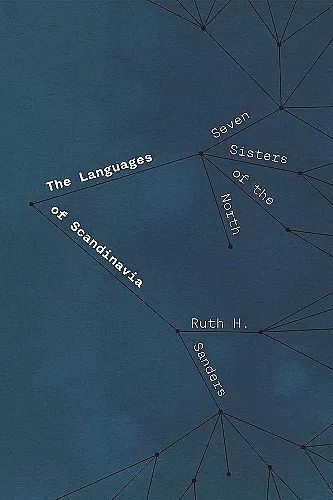The Languages of Scandinavia
Seven Sisters of the North
Format:Paperback
Publisher:The University of Chicago Press
Published:5th Feb '21
Should be back in stock very soon

From fjords to mountains, schools of herring to herds of reindeer, Scandinavia is rich in astonishing natural beauty. Less well known, however, is that it is also rich in languages. Home to seven languages, Scandinavia has traditionally been understood as linguistically bifurcated between its five Germanic languages (Danish, Norwegian, Swedish, Icelandic, and Faroese) and its two Finno-Ugric ones (Finnish and Sámi). In The Languages of Scandinavia, Ruth H. Sanders takes a pioneering approach: she considers these Seven Sisters of the North together.
While the two linguistic families that comprise Scandinavia’s languages ultimately have differing origins, the Seven Sisters have coexisted side by side for millennia. As Sanders reveals, a crisscrossing of names, territories, and even to some extent language genetics—intimate language contact—has created a body of shared culture, experience, and linguistic influences that is illuminated when the story of these seven languages is told as one. Exploring everything from the famed whalebone Lewis Chessmen of Norse origin to the interactions between the Black Death and the Norwegian language, The Languages of Scandinavia offers profound insight into languages with a cultural impact deep-rooted and far-reaching, from the Icelandic sagas to Swedish writer Stieg Larsson’s internationally popular Millennium trilogy. Sanders’s book is both an accessible work of linguistic scholarship and a fascinating intellectual history of language.
“A much-needed, comprehensive, and accessible overview of the interrelationship among these languages. . . . Throughout the book, Sanders makes a convincing argument about how languages, their perception, and even their definitions are simultaneously bound to multiple factors. Leaving out any one aspect from analysis—be it cultural or historical context, linguistic properties, the geographic or genealogical vicinity, or the mutual intelligibility between languages—would give a falsely simplified picture of the whole. . . . The Languages of Scandinavia is a welcome contribution. . . . Its strength lies in its inclusivity, and Sanders sees and describes contacts and encounters, whereas the scholarship has often focused on boundaries.” -- Ilmari Ivaska, University of Bologna * Scandinavian Studies *
“This book is structured in seven chapters that tell concurrently the individual and shared histories of the titular sister languages: the five Germanic Scandinavian languages (Danish, Norwegian, Swedish, Icelandic, and Faroese) and the two Finno-Ugric Scandinavian languages (Finnish and Sami). Though Sanders refers to the latter group as stepsisters, the blended family analogy—maintained throughout the narrative—enhances the presentation and sharpens the dramatic impact of the storytelling. The author’s perspective is unique in that she does not separate the Germanic languages from the Finno-Ugric languages despite their originating and modern-day differences; instead she considers moments of intersection and co-development as essential to all the stories. . . . Of particular interest are the discussions of the effect of the black death on Norwegian, the parallel and divergent paths in the development of Faroese and Icelandic, Sami variants as languages or dialects, and immigrants and ‘multiethnolects’ in modern-day Scandinavia. Recommended.” * Choice *
“This book focuses on contacts, colonialism, conflicts and causes of friction, and the resulting language developments from a macro perspective, investigating the Scandinavian languages from the point of view of their contacts rather than as static entities. This makes for a refreshing and pleasant read. It furthermore supplies a well-written introduction to the phonology, orthography, grammar, and linguistic varieties of each of the seven languages. It is especially laudable that Sámi and Faroese are included here, and that all ‘seven sisters’ appear on an equal footing. An extremely valuable and long-overdue overview of all the major languages spoken in Scandinavia.” -- Verena Höfig, University of Illinois at Urbana-Champaign
“Languages are constantly in flux, but it takes a rather long view to show just what a contingent and transitory thing a language can be at any point in time. Sanders takes just such a view. . . . Her biography ranges widely over not just linguistics, but also over archaeology and genetic history to tell the story of these prolific Indo-Europeans and their languages . . . . It is an ingenious telling of just how German emerged from the primordial Germanic soup, and how many other ways it could have been. . . . This is an enjoyable yet still-scholarly read for the historian, linguist, and Germanophile alike. It would be a fine thing to have more such brief histories, made easily readable to the non-specialist, of the major world languages.” * Economist, on Sanders's "German: Biography of a Language" *
"In understanding linguistic history to respond to as well as shape historical and cultural change, Sanders rightly emphasizes that the history of a language cannot be divorced from the history of its speakers and that language is embedded in a social context. What is more, linguistic history is rescued from the dusty libraries of philology and comes beautifully alive in the book when it is paired with stories of everyday life and material culture." -- Kerstin Hoge, University of Oxford * Times Literary Supplement, on Sanders's "German: Biography of a Language" *
“An approachable overview of the evolution of the German language and a history of its speakers.” * eLanguage, on Sanders's "German: Biography of a Language" *
“This is a book remarkable in numerous respects; remarkable not only because of the vast time frame of some 6,000 years selected for this ‘narrative,’ and not only because of the skillful and pervasively interesting manner in which the abundance of pertinent data is handled, but also because of the certainly unusual, yet all the same refreshingly captivating style which Sanders employs.” * German Politics and Society, on Sanders's "German: Biography of a Language" *
"For linguists and nonlinguists alike, The Languages of Scandinavia: Seven Sisters of the North...presents an engaging overview of language development, contact, and change in Scandinavian languages." -- Lara Schwarz * Journal of Germanic Linguistics *
ISBN: 9780226759753
Dimensions: 229mm x 152mm x 18mm
Weight: 286g
224 pages